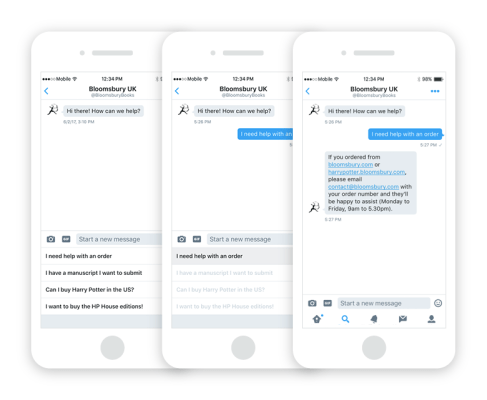These days, the idea of bots on Twitter might be associated more with accounts that auto-Tweet, auto-like, and auto-retweet messages, or are corralled into large armies that follow people and do other things en-masse. But as the idea of artificial-intelligence- driven messengers starts to take hold in the tech world, and specifically in areas like customer service, Twitter is positioning itself as a platform for these kinds of bots, too.
Sprout Social, a social media management company, is launching a new product called Bot Builder, to help clients build customer support chatbots for the platform. The bots will be used to answer basic questions to, say, verify a user’s identity and account information and other basic issues that form the start of customer support queries, so that they can progress the the next level of getting handled, Sprout Social’s co-founder Aaron Rankin said in an interview.
Enterprise bots on Twitter are not completely new, but the idea of using them for customer service is. Just last month, Twitter launched a new Direct Message Card that linked users from public timelines into direct message chats, to chat with bots.
But these were not about customer service; they were about marketing and interacting with brands for fun, such as a “bot tender” that helped you with drink recipes; or short-term and mostly fun experiments around quick transactions, such as this bot to order food from Denny’s.
Interestingly, for this move into customer service chat bots, Twitter has taken a route different from that of Facebook or others: it has chosen not to create a bot development platform of its own, but instead to work with third parties like Sprout to bring the concept to life and get more businesses using them.
“I think there are a bunch of reasons why we don’t build bot experience ourselves,” said Jeff Lesser, who heads up product marketing for Twitter Business Messaging. “There are millions of types of businesses that can use our platform, so we’re letting the ecosystem build the solutions that they need. We are focusing on building the canvas for them to do that.”
Sprout has rolled the Bot Builder into its enterprise tier of service — Sprout has some 18,000 customers using its services in all to help manage their Twitter presence — and over time may make it available in some form to other usage tiers. Twitter doesn’t take any cut at all on providing the platform for this. Its sales are made by way of the selling the Cards to businesses to direct users to using these experiences.
Turning to third parties to build these kinds of services is one way to promoting a wider developer ecosystem — something that Twitter hasn’t always been that good at doing. But another reason why Twitter may be holding bots at arm’s length is because of its history with them.
“We knew Twitter had a hesitancy about automation in accounts,” Sprout’s Rankin noted, referring to Twitter’s history with bot accounts — there areas in Twitter’s terms of service that lay out where it is still not allowed — “but now they’ve also started to introduce features to encourage some automation. I think between us and Twitter we’re responding to events happening in the world,” — specifically here, the rise of chatbots — “and looking at how to evolve the position.”
Twitter’s efforts to build more tools for enterprises is a long game for the company, with its first efforts in this area dating back to October 2015.
It’s still not as substantial a part of the business as the company’s efforts in advertising on the platform, but it’s also a very natural fit for the platform. People often turn to Twitter to reach out to businesses when they are unhappy with them or have questions because asking questions in a public forum feels much more immediate than sending emails or phoning random phone numbers.
Conversely, businesses use Twitter a lot to communicate things publicly. So pushing Twitter’s potential in doing more with customer service is a logical next step.
Rankin said that the Sprout Social service was built from the ground up, but with a very basic approach to “bots” that will potentially grow over time. “We are not focused on large AI problems,” he said. “We see utility in the low hanging fruit of getting through some of the basics.” Over time, as systems get smarter, this might change, he added.
Similarly, there are still some questions over what, exactly, the rules of engagement will be for these bots. Right now, we still don’t have a great way of identifying who is talking to you when multiple people are speaking from one account on Twitter, and you have to wonder what kind of response people will have if they know they are speaking with an actual human versus a machine.
“We’re encouraging a handoff to the bot that is transparent,” Rankin said. “The UX still needs to be worked out but the short answer is that there are features to do this, and the design of our product can encourage it.”
This seems to be Twitter’s view, too, the company is making efforts to personalise “accounts” for businesse, with users able to differentiate and distinguish between different individuals responding from that account.
“We don’t want brands to create new accounts for bots,” said Lesser. “We want to build them into the accounts that people are [already] used to seeing.”
